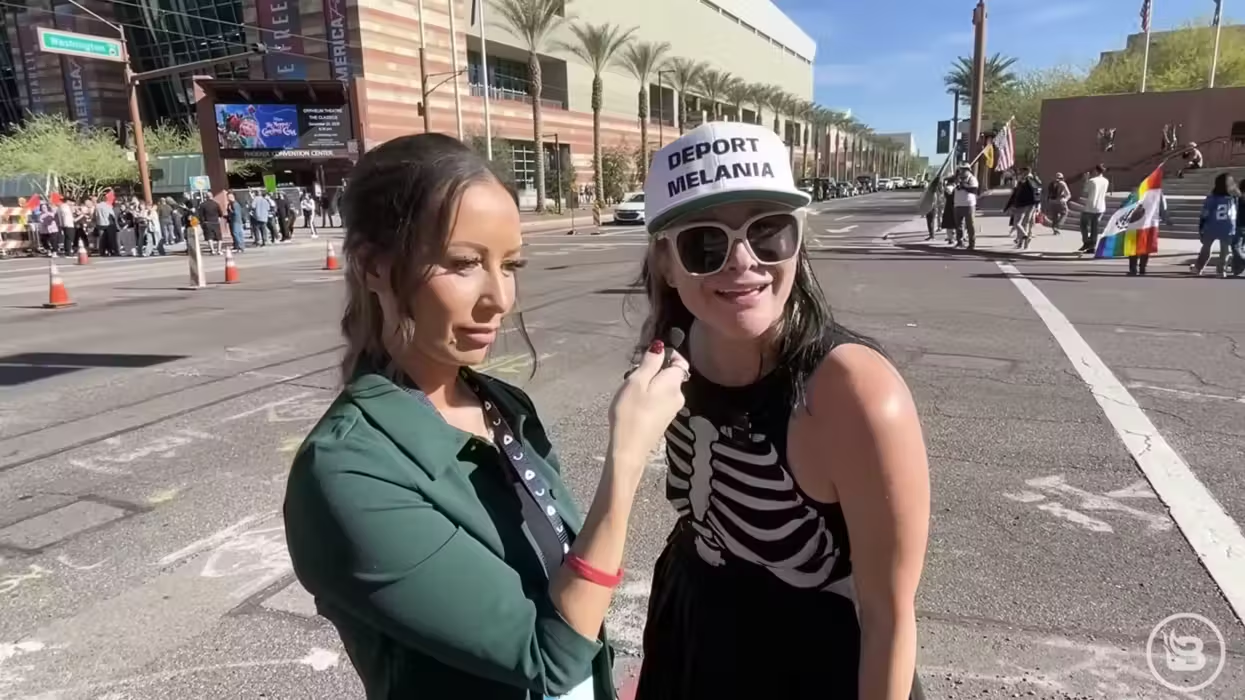
© 2025 Blaze Media LLC. All rights reserved.
“So where are the angry crowds, the demonstrations, sit-ins and unruly mobs?”
Who's really calling for violence, Glenn Beck or Frances Fox Piven?
There's been some talk recently criticizing Glenn Beck for speaking out against Frances Fox Piven and her calls for "angry" revolution. For example, the New York Times ran a story over the weekend saying Beck's expose of Piven's strategy to overwhelm the government welfare rolls and have people rise up (and the stories about that on The Blaze) has incited violence. Piven's favorite soap box The Nation ran a similar story on Thursday. Both stories references a few errant comments left on this website.
But lacking from those stories, and from the stories of the other outlets that have picked them up, is not only Beck's numerous calls for non-violence, but also any legitimate look at what Piven has said. Stanley Kurtz on National Review Online today noticed as much:
An article by Brian Stelter in Saturday’s New York Times is a thinly disguised gesture of support for The Nation’s campaign. The piece downplays Piven’s radicalism, noting that her widely criticized call for intentionally creating a political and economic crisis in America’s welfare system was made 45 long years ago. Although Piven has freely described her own strategy as an effort to set off “fiscal and political crises in the cities,” Stelter delicately avoids the word “crises,” writing instead of “fiscal and political stress.”
Kurtz points out, however, that violence is an integral part of the Cloward-Piven strategy:
Calls for the escalation and manipulation of violent rioting have long been central to Piven’s strategy. Her 1977 book with Cloward, Poor People’s Movements: Why They Succeed, How They Fail, detailed the rationale behind the infamous crisis strategy of a decade before. The core argument is that the poor and unemployed are so isolated from the levers of power in America that their greatest potential impact is to withhold “quiescence in civil life: they can riot.”At the heart of the book, Cloward and Piven luxuriously describe instances of “mob looting,” “rent riots,” and similar disruptions, egged on especially by Communist-party organizers in the 1930s. Many of those violent protests resulted in injuries. A few led to deaths. The central argument of Poor People’s Movements is that it was not formal democratic activity but violent disruptions inspired by leftist organizers that forced the first great expansion of the welfare state.
Toward the end of the book, when Cloward and Piven describe their own work with the National Welfare Rights Organization, they treat the violent urban rioting of the Sixties as a positive force behind that era’s expansion of the welfare state.
So what has Piven been talking about? Below is a montage of quotes and clips of her explaining her strategy, which includes violence:
Violence is okay as long as it's part of a bigger strategy:
In a piece from The Nation in December, Piven says the unemployed must get angry, and explains that an effective jobless movement will look like the violent riots in Greece and England:
“So where are the angry crowds, the demonstrations, sit-ins and unruly mobs?” she writes. “After all, the injustice is apparent. Working people are losing their homes and their pensions while robber-baron CEOs report renewed profits and windfall bonuses. Shouldn’t the unemployed be on the march? Why aren’t they demanding enhanced safety net protections and big initiatives to generate jobs?” [...]An effective movement of the unemployed will have to look something like the strikes and riots that have spread across Greece in response to the austerity measures forced on the Greek government by the European Union, or like the student protests that recently spread with lightning speed across England in response to the prospect of greatly increased school fees. [Emphasis added]
Here Piven says there needs to be "tumult disorder pressure" in order to force Barack Obama to "make choices":
Piven saying that with the financial crisis, "all the pieces are in place for a massive defiant movement":
And finally, Piven explaining how effective strikes "cause a lot of trouble":
It's the above videos that the New York Times and others have ignored. The better story, it seems to those outlets, is painting those who point out violent rhetoric as violent rather than looking into their claims.
As a final point, we don't expect Piven to stop talking about her ideas. Thus, will be a story that we'll update in the future whenever necessary.
Read more about Piven here and here. Additionally, Kurtz writes extensively about Piven in his book, Radical-in-Chief.
Editor's note: A reminder that comments are monitored. The Blaze retains the right to delete comments it deems inappropriate, as well as the right to ban those who write them.
Want to leave a tip?
We answer to you. Help keep our content free of advertisers and big tech censorship by leaving a tip today.
Want to join the conversation?
Already a subscriber?
Jonathon M. Seidl is a former managing editor of Blaze News and a best-selling author and speaker. His next book, “Confessions of a Christian Alcoholic,” will be released on October 7, 2025.
Jonathon M. Seidl
Jonathon M. Seidl is a former managing editor of Blaze News and a best-selling author and speaker. His next book, “Confessions of a Christian Alcoholic,” will be released on October 7, 2025.
more stories
Sign up for the Blaze newsletter
By signing up, you agree to our Privacy Policy and Terms of Use, and agree to receive content that may sometimes include advertisements. You may opt out at any time.
Related Content
© 2025 Blaze Media LLC. All rights reserved.
Get the stories that matter most delivered directly to your inbox.
By signing up, you agree to our Privacy Policy and Terms of Use, and agree to receive content that may sometimes include advertisements. You may opt out at any time.






